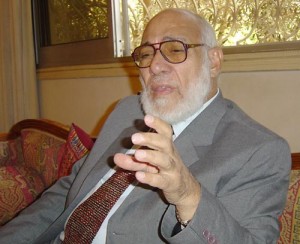Earth Sciences Professor — Egypt
 Commenting on the process of destruction, annihilation and recreation of the universe, the Ever-Glorious Qur’an reads:
Commenting on the process of destruction, annihilation and recreation of the universe, the Ever-Glorious Qur’an reads:
The Day We roll up the heavens with the same parallel of a scroll rolling up books; as We produced the first creation We repeat it, a promise We have undertaken, verily We shall fulfill it. (Al-Anbiya’ 21: 104)
Early commentators on the Ever-Glorious Qur’an saw in this verse a divine promise to fold up the universe as a scroll of parchment folds the contents of books written on its inner side; and as Allah the Almighty created all this universe out of nothing, so can He destroy it to nothing, and create an entirely new one.
This interpretation is correct, but from the purely semantic analysis of the verse it clearly implies that in as much as the present-day universe started from an initial singularity, its end will come again to the same form, through the folding and rolling up of the universe as a scroll folds the letters, words and sentences written inside it as it is rolled up.
In clear concordance with this interpretation, the most widely accepted “hot big bang model” for the origin of our expanding universe (Gamow, 1948), implies that such expansion cannot continue forever, rather it must end in a reverse process of contraction. Due to such contraction, all of the material of the universe would eventually come back to a central point (exactly similar to what the universe initially began with) in an implosion that would annihilate all forms of matter (atoms, molecules, compounds, planets, stars, galaxies, galactic clusters and super clusters, etc.). The result would be a singularity – identical to the initial one – that will explode and start the production of an earth other than ours and of heavens different from the present-day ones, in exactly the same way the initial singularity behaved.
Two Bangs Instead of One
The scientific reasoning behind this expectation is the fact that the motion of recession of the galaxies in our expanding universe does not proceed with constant velocity. The force of gravitation attracts these galaxies, supergalaxies and clusters to each other. This mutual attraction tends to decelerate the expansion, despite the very weak pull of gravity in view of the enormous inter-galactic distances. Nevertheless, this very small deceleration can become important in the long run, to the extent of hindering the process of expansion to a big halt. If this motion of galactic recession stops, the galaxies will begin to fall back towards each other. The universe will then start to contract, the galaxies will gradually come closer together, the gravitational pull will become gradually greater, and the velocities of contraction will become excessively larger with time. Finally, the galaxies will collide with one another, and the universe will collapse in a cosmic implosion, generally described as the “big crunch”. This cosmic disaster will end by an extremely small, hot, dense singularity, identical to the initial singularity that exploded in the “first big bang”. This second singularity is also expected to explode in a “second big bang”, leading to a new cosmos.
The most widely accepted scenario of the “first big bang”, followed by the formation of smoky nebulae in which the nuclei of matter started to form, small and large scale structures started to condense from fluctuations in the density of matter that would have seeded galaxies, followed by the expansion (or inflation) of the universe, then its expected contraction (or big crunch), the expected ” second big bang”, followed by the creation of new cosmos, are beautifully described in the following Qur’anic verses:
Have those who disbelieved not considered that the heavens and the earth were a joined entity, and We separated them and made from water every living thing? Then will they not believe? (Al-Anbiya’ 21:30);
Then He directed Himself to the heaven while it was smoke and said to it and to the earth, “Come [into being], willingly or by compulsion.” They said, “We have come willingly.” (Fussilat 41:11);
And the heaven We have constructed with strength, and indeed, We are [its] expander. (Adh-Dhariyat 51:47);
The Day when We will fold the heaven like the folding of a [written] sheet for the records. As We began the first creation, We will repeat it. [That is] a promise binding upon Us. Indeed, We will do it. (Al-Anbiya’ 21:104); and,
The day when the earth is replaced by a different earth, and so are the heavens… (Ibrahim 14: 48)
In any Islamic science curriculum such Qur’anic verses cannot be overlooked. These represent the word of The Creator, in an area (of origin, annihilation and recreation of the universe) that does not fall within the direct observation of man. As man’s knowledge in this area cannot exceed the limit of theorization, these 5 Qur’anic verses come to us as a guiding light for choosing between heaps of human ideas that can do no more than confuse the human intellect.
———————————–
Courtesy Onislam.net with slight modifications.
